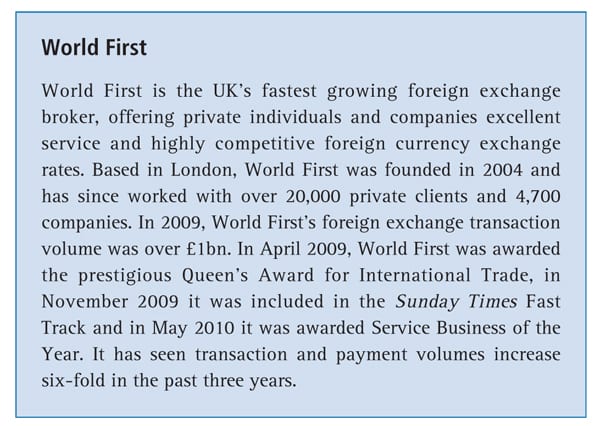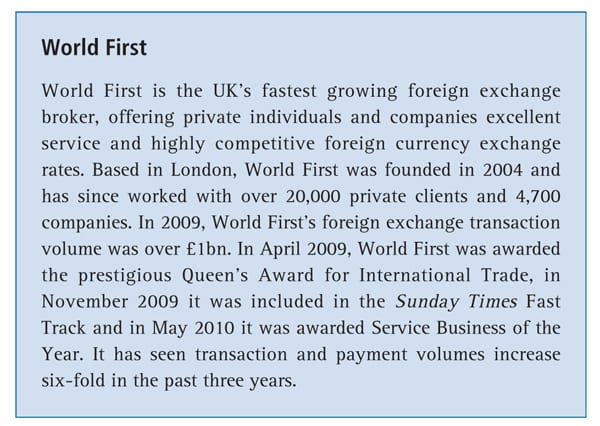After the Ballots
How the ‘year of elections’ reshaped treasury priorities
Published: October 25, 2010

World First was founded to provide small and medium-sized enterprises (SMEs) and private individuals with a personalised and responsive foreign exchange (FX) service with excellent exchange rates. Furthermore, World First is able to offer foreign exchange options and derivatives, usually only available to larger companies. As a result, we have seen rapid growth over the past five years, growing from three to 98 staff, and exponential expansion in trade volumes; for example, our payment volume has increased by 400% over two years. We can provide FX services in most tradable currencies, and provide both ad-hoc and regular transactions to our clients. Clients use our services for a variety of reasons; private clients are usually buying property abroad, emigrating or sending money to their overseas accounts. Corporate clients are usually importing or exporting.
While our payment volumes were still small, it was relatively straightforward for our payments team to fax payment instructions or input them into our banks’ online payment systems. However, our goal has always been to offer the most responsive, reliable service possible, so as our volumes increased, we wanted to implement a more reliable solution to avoid the risk of error and enhance our operational efficiency. There were various elements to this. Firstly, we needed a highly functional and automated back-office system for transaction processing. Secondly, we needed to extend efficient straight-through processing (STP) through to our banking partners.

We therefore made the decision to build a back-office system that facilitates end-to-end STP from customer request through compliance checking to payment. Customers can access the system directly to transact online, or contact us by telephone. We made the decision to build our own system as opposed to licensing a third-party system as we recognised that a system that was designed around our needs, and to which we could add functionality very rapidly, would be a major strategic and competitive advantage. We now have nine dedicated IT developers who can enhance our system in line with customer priorities and to enable us to provide the best possible customer service. Our system is integrated with a variety of specialist applications, such as an external credit tool and Accuity for checking bank account details online. Any necessary approvals can be done within the system according to customer-specific rules, and incoming and outgoing payment information exchanged with our banks. We then cover our risk automatically with key partner bank, Barclays.
One of our objectives as a business is to provide a highly responsive service to our customers, so we need to identify incoming payments promptly, then make the onward payment to the customer’s requested beneficiary as quickly as possible. We have established challenging service level agreements with our customers by guaranteeing same-day payment for transactions where we receive the client’s funds before cut-off time. To achieve this, we need immediate notification of incoming payments for automatic reconciliation, and the ability to make payments quickly, securely and reliably. World First was one of Barclays Corporate’s first users of its web-based banking system, Business Internet Banking, a solution that we found very reliable and user-friendly. However, we couldn’t integrate this system with our back-office system, so with rapidly increasing daily payment volumes, we were seeking a solution that provided industry-leading automation, security and rapid information flows. [[[PAGE]]]

We have worked closely with Barclays Corporate since World First was first incorporated, and the bank has been very supportive of our business as it has grown. We continue to benefit from their advice and support, and we make more than 50% of our payments with the bank. Consequently, in 2008, we approached Barclays Corporate to discuss our connectivity options, and they were quick to recommend SWIFT Corporate Access. Based on this advice and our own research, we recognised that SWIFT was a compelling option for us, by being able to make payments and retrieve statements globally in a secure, automated way. We did not want to maintain the technical infrastructure to maintain a direct connection to SWIFTNet (the SWIFT network) but Barclays Corporate suggested SMA Financial as a service bureau, with whom the bank has a close relationship. We evaluated three service bureaus and finally selected SMA Financial based on its expertise, competitive pricing and the quality of service. The relationship with Barclays Corporate was an important consideration; the implementation team from Barclays Corporate and SMA were very experienced and had worked together in the past so they managed the process well.
We connected to SWIFTNet in January 2009, and then tested our BIC set-up and tested the initial message types we would send and receive: MT 101 (Request for Transfer); MT 103 (Single Customer Credit Transfer); MT195 (Queries) and MT 942 (Intraday Transaction Statements). We went live in April 2009. Our system creates messages in the appropriate format and stores the payment until the credit from the client has been received, at which point it is automatically released. In this way, we have achieved full STP from our system to conclusion on 99.8% of our international payments, with the only manual intervention for checking and approval. The project benefited considerably from the ongoing support of the Barclays Corporate team. We have excellent relationship managers with whom we work closely, and we had regular contact with Barclays Corporate’s technical team throughout the project and close integration between our systems. A key factor in a successful banking partnership is accurate, timely processing and a quick resolution of issues. We have been very satisfied with our relationship with Barclays Corporate over a number of years.
We have seen a considerable reduction in the time taken to complete transactions, increasing our operational efficiency and enhancing the service we provide to customers. By using SWIFT for exceptions and investigations, we have also reduced the time taken to deal with queries, therefore further enhancing our customer service. We can now provide immediate and automatic proof of payment to customers based on MT103 messages, which is highly beneficial for them as they can pass this on to the beneficiary. We also import intra-day bank statements for immediate reconciliation of incoming payments so we can transfer funds to the beneficiary very rapidly. [[[PAGE]]]
The implementation of bank connectivity through SWIFT has been one element of an interconnected series of projects that are designed to improve process efficiency and enhance the quality and breadth of services that we are able to offer. For example, we have integrated our back-office system with an on-line trading platform to provide a full, secure self-service capability for dealing, sending payments and setting up direct debits as well as retrieving information. In the past, we have generally promoted our service to customers seeking to make individual or low volumes of beneficiary payments at once. Due to the level of process automation that we are able to achieve, we can now offer a service to clients with higher volumes of foreign currency payments, such as travel agents paying hotels or airlines, without the need to increase staffing levels. To do this, we are providing a flexible user interface (FXAutoPay) for input or uploading of payments, enhancing our clients’ own STP capabilities.
